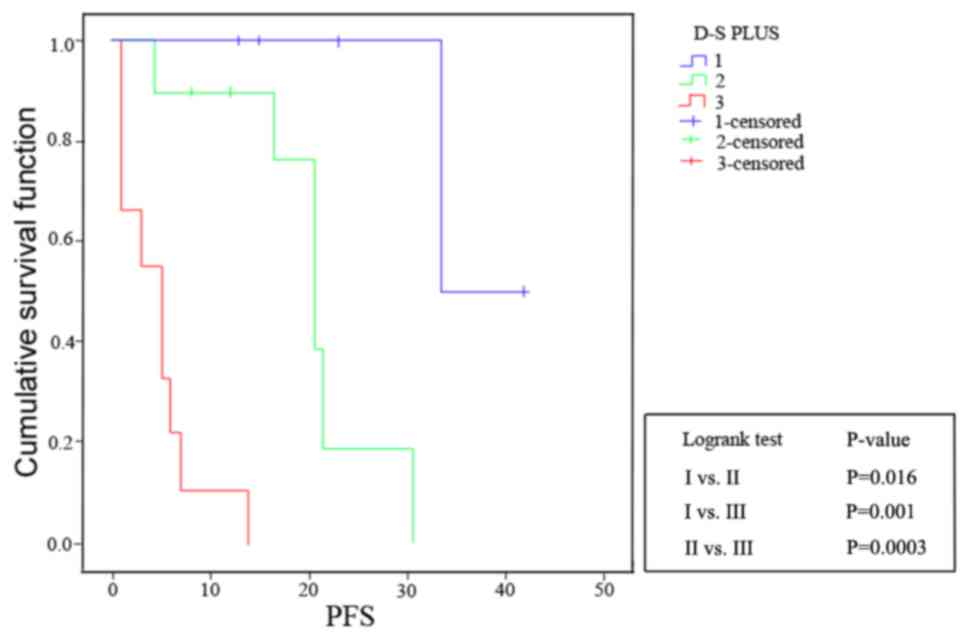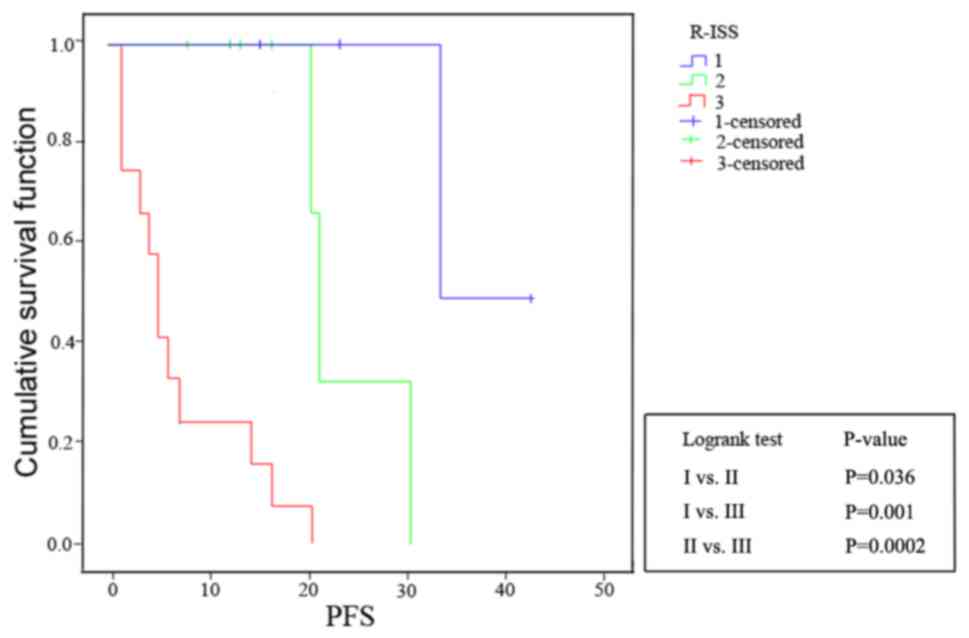|
1
|
Durie BG, Kyle RA, Belch A, Bensinger W,
Blade J, Boccadoro M, Child JA, Comenzo R, Djulbegovic B, Fantl D,
et al: Myeloma management guidelines: A consensus report from the
scientific advisors of the International Myeloma Foundation.
Hematol J. 4:379–398. 2003.PubMed/NCBI
|
|
2
|
Dimopoulos M, Kyle R, Fermand JP, Rajkumar
SV, San Miguel J, Chanan-Khan A, Ludwig H, Joshua D, Mehta J, Gertz
M, et al: Consensus recommendations for standard investigative
workup: Report of the International Myeloma Workshop Consensus
Panel 3. Blood. 117:4701–4705. 2011.PubMed/NCBI View Article : Google Scholar
|
|
3
|
Durie BG and Salmon SE: A clinical staging
system for multiple myeloma. Correlation of measured myeloma cell
mass with presenting clinical features, response to treatment, and
survival. Cancer. 36:842–854. 1975.PubMed/NCBI View Article : Google Scholar
|
|
4
|
International Myeloma Working Group.
Criteria for the classification of monoclonal gammopathies,
multiple myeloma and related disorders: A report of the
International Myeloma Working Group. Br J Haematol. 121:749–757.
2003.PubMed/NCBI
|
|
5
|
Mesguich C, Fardanesh R, Tanenbaum L,
Chari A, Jagannath S and Kostakoglu L: State of the art imaging of
multiple myeloma: Comparative review of FDG PET/CT imaging in
various clinical settings. Eur J Radio. 83:2203–2223.
2014.PubMed/NCBI View Article : Google Scholar
|
|
6
|
van Lammeren-Venema D, Regelink JC,
Riphagen II, Zweegman S, Hoekstra OS and Zijlstra JM:
18F-Fluoro-deoxyglucose positron emission tomography in
assessment of myeloma-related bone disease: A systematic review.
Cancer. 118:1971–1981. 2012.PubMed/NCBI View Article : Google Scholar
|
|
7
|
Cavo M, Terpos E, Nanni C, Moreau P,
Lentzsch S, Zweegman S, Hillengass J, Engelhardt M, Usmani SZ,
Vesole DH, et al: Role of 18F-FDG PET/CT in the
diagnosis and management of multiple myeloma and other plasma cell
disorders: A consensus statement by the International Myeloma
Working Group. Lancet Oncol. 18(e206-e217)2017.PubMed/NCBI View Article : Google Scholar
|
|
8
|
Chantry A, Kazmi M, Barrington S, Goh V,
Mulholland N, Streetly M, Lai M and Pratt G: British Society for
Haematology Guidelines. Guidelines for the use of imaging in the
management of patients with myeloma. Br J Haematol. 178:380–393.
2017.PubMed/NCBI View Article : Google Scholar
|
|
9
|
Nanni C, Versari A, Chauvie S, Bertone E,
Bianchi A, Rensi M, Bellò M, Gallamini A, Patriarca F, Gay F, et
al: Interpretation criteria for FDG PET/CT in multiple myeloma
(IMPeTUs): Final results. IMPeTUs (Italian myeloma criteria for PET
USe). Eur J Nucl Med Mol Imaging. 45:712–719. 2018.PubMed/NCBI View Article : Google Scholar
|
|
10
|
Palumbo A, Avet-Loiseau H, Oliva S,
Lokhorst HM, Goldschmidt H, Rosinol L, Richardson P, Caltagirone S,
Lahuerta JJ, Facon T, et al: Revised international staging system
for multiple myeloma: A report from international myeloma working
group. J Clin Oncol. 33:2863–2869. 2015.PubMed/NCBI View Article : Google Scholar
|
|
11
|
Rajkumar SV, Dimopoulos MA, Palumbo A,
Blade J, Merlini G, Mateos MV, Kumar S, Hillengass J, Kastritis E,
Richardson P, et al: International Myeloma Working Group updated
criteria for the diagnosis of multiple myeloma. Lancet Oncol.
15(e538-e548)2014.PubMed/NCBI View Article : Google Scholar
|
|
12
|
Baur-Melnyk A, Buhmann S, Becker C,
Schoenberg SO, Lang N, Bartl R and Reiser MF: Whole-body MRI versus
whole-body MDCT for staging of multiple myeloma. AJR Am J
Roentgenol. 190:1097–1104. 2008.PubMed/NCBI View Article : Google Scholar
|
|
13
|
Gariani J, Westerland O, Natas S, Verma H,
Cook G and Goh V: Comparison of whole body magnetic resonance
imaging (WBMR imaging) to whole body computed tomography (WBCT) or
18F-fluorodeoxyglucose positron emission tomography/CT
(18F-FDG PET/CT) in patients with myeloma: Systematic
review of diagnostic performance. Crit Rev Oncol Hematol.
124:66–72. 2018.PubMed/NCBI View Article : Google Scholar
|
|
14
|
Terpos E, Kleber M, Engelhardt M, Zweegman
S, Gay F, Kastritis E, van de Donk NW, Bruno B, Sezer O, Broijl A,
et al: European Myeloma Network guidelines for the management of
multiple myeloma-related complications. Haematologica.
100:1254–1266. 2015.PubMed/NCBI View Article : Google Scholar
|
|
15
|
Zamagni E, Patriarca F, Nanni C, Zannetti
B, Englaro E, Pezzi A, Tacchetti P, Buttignol S, Perrone G, Brioli
A, et al: Prognostic relevance of 18-F FDG PET/CT in newly
diagnosed multiple myeloma patients treated with up-front
autologous transplantation. Blood. 118:5989–5995. 2011.PubMed/NCBI View Article : Google Scholar
|
|
16
|
Bartel TB, Haessler J, Brown TL,
Shaughnessy JD Jr, van Rhee F, Anaissie E, Alpe T, Angtuaco E,
Walker R, Epstein J, et al: F18-fluorodeoxyglucose positron
emission tomography in the context of other imaging techniques and
prognostic factors in multiple myeloma. Blood. 114:2068–2076.
2009.PubMed/NCBI View Article : Google Scholar
|
|
17
|
Nanni C, Zamagni E, Celli M, Caroli P,
Ambrosini V, Tacchetti P, Brioli A, Zannetti B, Pezzi A, Pantani L,
et al: The value of 18F-FDG PET/CT after autologous stem
cell transplantation (ASCT) in patients affected by multiple
myeloma (MM): Experience with 77 patients. Clin Nucl Med.
38(e74-e79)2013.PubMed/NCBI View Article : Google Scholar
|
|
18
|
Rasche L, Angtuaco E, McDonald JE, Buros
A, Stein C, Pawlyn C, Thanendrarajan S, Schinke C, Samant R,
Yaccoby S, et al: Low expression of hexokinase-2 is associated with
false-negative FDG-positron emission tomography in multiple
myeloma. Blood. 130:30–34. 2017.PubMed/NCBI View Article : Google Scholar
|
|
19
|
Herrmann K, Schottelius M, Lapa C, Osl T,
Poschenrieder A, Hänscheid H, Lückerath K, Schreder M, Bluemel C,
Knott M, et al: First-in-human experience of CXCR4-Directed
endoradiotherapy with 177Lu- and 90Y-Labeled
pentixather in advanced-stage multiple myeloma with extensive
intra- and extramedullary disease. J Nucl Med. 57:248–251.
2016.PubMed/NCBI View Article : Google Scholar
|
|
20
|
Okasaki M, Kubota K, Minamimoto R, Miyata
Y, Morooka M, Ito K, Ishiwata K, Toyohara J, Inoue T, Hirai R, et
al: Comparison of (11)C-4'-thiothymidine, (11)C-methionine, and
(18)F-FDG PET/CT for the detection of active lesions of multiple
myeloma. Ann Nucl Med. 29:224–232. 2015.PubMed/NCBI View Article : Google Scholar
|
|
21
|
Lonial S and Kaufman JL: Non-secretory
myeloma: A clinician's guide. Oncology (Williston Park).
27(924-928, 930)2013.PubMed/NCBI
|
|
22
|
Dammacco F, Rubini G, Ferrari C, Vacca A
and Racanelli V: 18F-FDG PET/CT: A review of diagnostic
and prognostic features in multiple myeloma and related disorders.
Clin Exp Med. 15:1–18. 2015.PubMed/NCBI View Article : Google Scholar
|
















